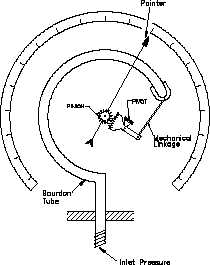PRESSURE DETECTORS
Pressure Detectors
The bellows is a one-piece, collapsible, seamless metallic unit that has deep folds formed from
very thin-walled tubing. The diameter of the bellows ranges from 0.5 to 12 in. and may have
as many as 24 folds. System pressure is applied to the internal volume of the bellows. As the
inlet pressure to the instrument varies, the bellows will expand or contract. The moving end of
the bellows is connected to a mechanical linkage assembly. As the bellows and linkage assembly
moves, either an electrical signal is generated or a direct pressure indication is provided. The
flexibility of a metallic bellows is similar in character to that of a helical, coiled compression
spring. Up to the elastic limit of the bellows, the relation between increments of load and
deflection is linear.
However, this relationship exists only when the bellows is under
compression. It is necessary to construct the bellows such that all of the travel occurs on the
compression side of the point of equilibrium. Therefore, in practice, the bellows must always
be opposed by a spring, and the deflection characteristics will be the resulting force of the spring
and bellows.
Bourdon Tube-Type Detectors
Figure 2 Bourdon Tube
The
bourdon
tube
pressure
instrument is one of the oldest
pressure sensing instruments in use
today. The bourdon tube (refer to
Figure 2) consists of a thin-walled
tube that is flattened diametrically
on opposite sides to produce a
cross-sectional area elliptical in
shape, having two long flat sides
and two short round sides. The
tube is bent lengthwise into an arc
of a circle of 270 to 300 degrees.
Pressure applied to the inside of
the tube causes distention of the
flat sections and tends to restore
its original round cross-section.
This change in cross-section causes
the tube to straighten slightly.
Since the tube is permanently fastened at one end, the tip of the tube traces a curve that is the
result of the change in angular position with respect to the center. Within limits, the movement
of the tip of the tube can then be used to position a pointer or to develop an equivalent electrical
signal (which is discussed later in the text) to indicate the value of the applied internal pressure.
IC-02
Page 2
Rev. 0






